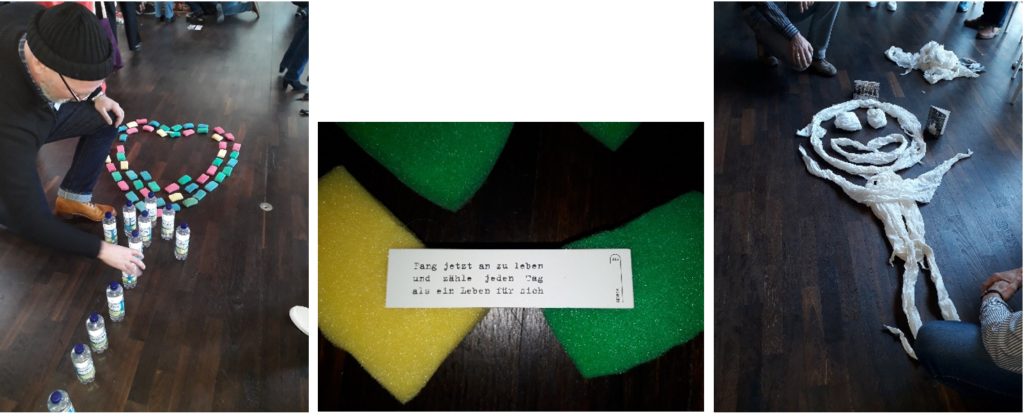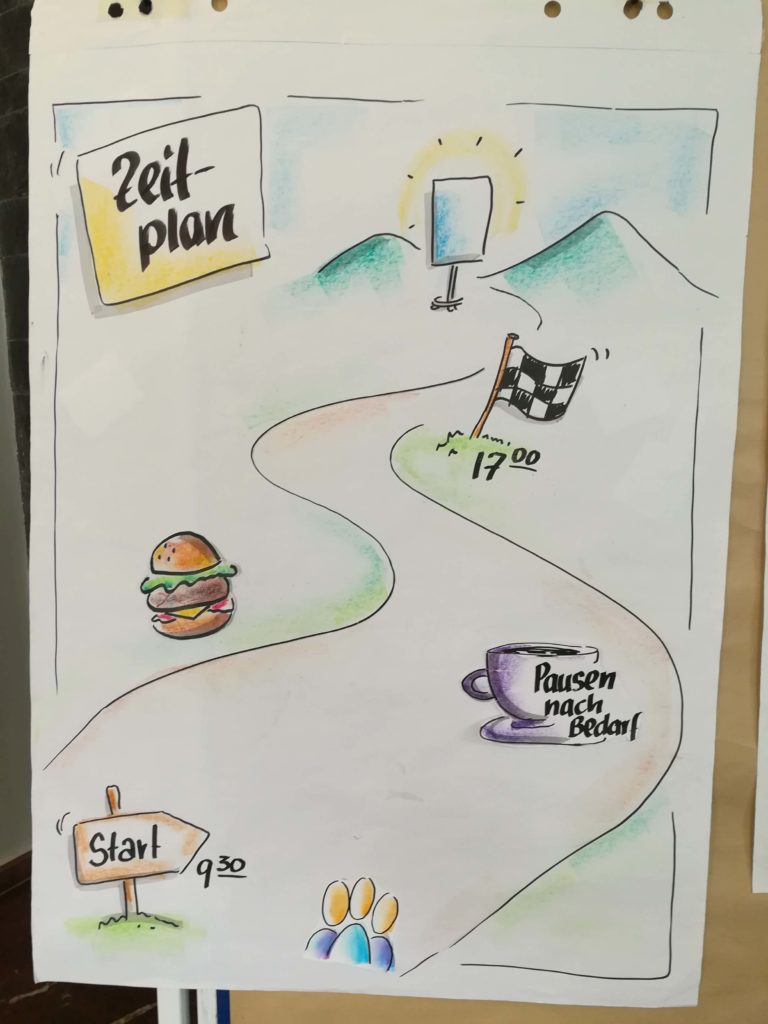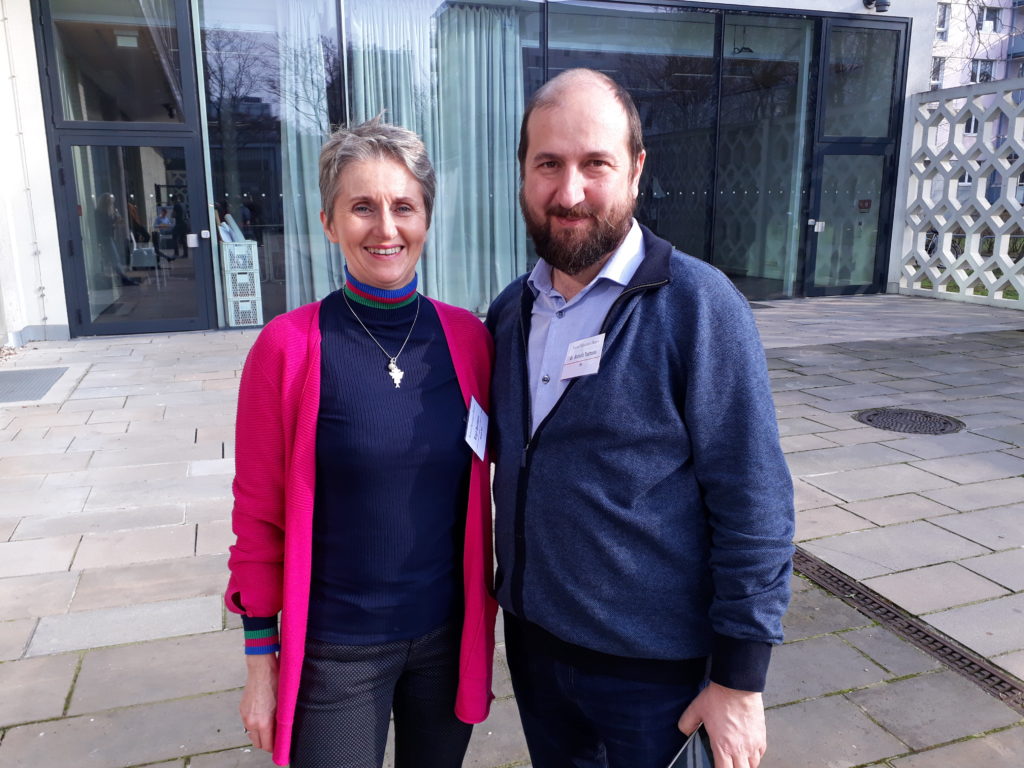Trainer Congress 2019 in Berlin: Inspirations, methods, short formats, team development, tips & tricks, digital & analogue, and much more
The Trainer Congress in Berlin took place for the 11th time from 22 to 23 March, 2019, organised by Gert and Angelika Schilling. It was already my 9th time there, and that says a lot. Why? Again and again inspiration, acknowledgement, methods, stimulating discussions, reflections on my own work and activities.
Today I’m going to tell you about 4 sessions in which I took part (from the approx. 60 offered) and in addition there are 2 guest articles by Sabine Kainrath (Siemens) and Michalis Tzatzanis (FFG):
- A Heart for the Team – Tools for Seminars & Workshops with Team (Amelie Funke)
- Learning Spaces of the Future. How to Score with Micro Training (Barbara Messer & Thea Messer)
- How to Increase Your Training’s Transfer Success (Ina Weinbauer-Heidel)
- Mix-it, Baby! Actively Integrating the Smartphone into Training Sessions (Bernd Braun & Hanne Philipp)
- Training Needs Analysis (Anna Langheiter)
- Easily Learn How to Draw Business Symbols (Johannes Sauer)
1. A Heart for the Team – Tools for Seminars & Workshops with Team (Amelie Funke)
Of the 5 methods presented, I will describe the “Great Moment” which brings out your participants‘ personal strengths. It’s very easy to implement:
Pairs are formed that tell each other about a situation that spelled a “Great Moment” for them (you define the respective context.) In the next step, strengths are identified, e.g. what was so special about the situation? Why was it so brilliant? What did you contribute to make it a “Great Moment”? etc. The answers are written down.
I can imagine that this method would be good for team development workshops, as it immediately creates a positive mood and avoids deficit orientation.
2. Learning Spaces of the Future. How to Score with Micro Training (Barbara Messer & Thea Messer)
The core message, as in the previous year: the demand is for shorter and shorter training courses, which means that the core of the topic has to be peeled out, compacted, knowledge compressed. The upshot: What is the essence of the topic? And then of course convey it, short and crisp, to the participants – and as interactively as possible – whereby a mixture of analogue and digital can be used by all means. E.g. a video can be filmed, i.e. I film myself as the trainer and send it to the participants in advance. Or the other way around. The participants are given a task, film themselves (e.g. using their mobile phones, they are then in a comfort zone) and send it to the trainers beforehand, who can watch them first and prepare feedback. You can also film the methods and play the videos before or after the face-to-face training sessions.
The important thing to remember is that the information has to be REMARKABLE (worth remarking on) i.e. emotions have to come into play (one of the neurodidactic principles.)
So-called association methods are also suitable for both small and large groups; in the specific case we tried out, quotes were handed out, and many objects. The quotes are then “recreated” and can look like this, for example:

3. How to Increase Your Training’s Transfer Success (Dr. Ina Weinbauer-Heidel)
Ina is an academic and yet still manages to give a very inspiring and lively presentation (in my experience, I practically only know the opposite, unfortunately … as if it were a contradiction in itself).
Unfortunately, research shows that only about 15 % of what was learned is implemented in the long term. But there is a lot you can do to achieve a higher rate. Ina extracted the essence from approx. 100 studies, and from this developed 12 switch levers, two of which she presented in the session. I will now concentrate on the so-called “transfer volition“ i.e. ensuring that transfer is already worked on consistently during training. The aim is to activate the “Pippi Longstocking” in the participants. What this refers to is activating our “impulsive system” in such a way that it overrides our “reflective system” (the “Mr. Spock” inside us).
To do this, 3 factors are important:
Trigger: how can we lead our participants to remember and implement what was newly learned EXACTLY in that action situation?
This would be possible, for example, by giving every participant an object that reminds them of the learning situation in the training course. Or they draw their learnings and lay the picture, clearly visible, on the desk.
Fun: How can we lead our participants to experiencing positive emotions as they implement what was learned? How can we combine it with something pleasant?
Scientifically, this is also referred to as the „Nudging fun Theory“. Take a look at what this could mean: https://www.youtube.com/watch?v=2lXh2n0aPyw
Social: How can we ensure that participants are observed during implementation i.e. that they feel they are being observed?
This is when it’s time to haul our trainees’ managers on board.
I try to consider all of these factors as a trainer, for example in that I very quickly let the trainees slip into the role of trainers or moderators during train-the-trainer seminars of moderation workshops. That means – trying out, having fun, getting feedback, in a controlled environment. Lots of feedback rounds are also built in to assure transfer. On top of that, we have recently begun using the online learning assistant blink.it, that aims to ensure that trainees stay on the ball in that they continue to receive learning tidbits even after the workshop or seminar (see experience report).
However – as with so many other things – there is still room for improvement ?
4. Mix-it, Baby! Actively Integrating the Smartphone into Training Sessions (Bernd Braun & Hanne Philipp)
As the title says, this was about involving smartphones during training. Of the demonstrated applications, Mentimeter appeared the most useful to me, e.g. to quiz the audience (and we’ve already used it, e.g. during the closing event of the mobility turnaround stakeholder process).
5. Training Needs Analysis (Anna Langheiter)
If you want to build a house, or hold a good training course – then good planning is essential!
In her role as a training designer, Anna developed a model that makes is possible to analyse training needs in max. 3 hours together with the customer.To do this, a one-page document (canvas) is filled out together and also signed by the customer. This form contains the following boxes, which I would now like to describe for you in more detail.
Starting Point: Clarify: What is the problem? What are the consequences of the problem? What is the desired result (not in terms of money)?
Learning Goals: What should the participants know at the end of the seminar? Have the participants realized what’s in it for them in this training course? In other words, is there emotional agreement? What should they be able to use?
Target Group: What are all the things I want to know about the participants? E.g. function, role, standard of knowledge, number of participants …
Content: These are the topics the participants really know a lot about, which ones do they want?
Transfer: by all means already beforehand, e.g. working with live-online training; following this training, ask: where were you before the seminar? And now? Ask again after 3-6 months.
In this phase of transfer support, Anna proposes two possible avenues. Either the manager in charge is responsible for the progress, and if this doesn’t really work, then the participants can choose a change observer from their company network to obtain feedback.
Organisational issues: e.g. location, room, seminar documents, dates, duration (often gets tangled up with the planned content! One can negotiate here)
Evaluation: Very often customers want to talk about the contents first – absolutely let them, and confirm, and ask if there is anything else they want? You can only move on to filling in the other boxes, e.g. Starting Point, once the customer has unloaded all that first.
With this method, a lot of necessary input is generated within a short time. And those who ask, lead!
Have fun trying it out! Best, Sabine
0
6. Easily Learn How to Draw Business Symbols (Johannes Sauer)

This workshop was about learning how to draw simple images in order to increase the impact of your own flipcharts with hand-drawn business symbols. Johannes Sauer demonstrated easy step-by-step methods, e.g. how to draw a coffee cup, shade it and colour it using wax crayons. Even I, an absolute newcomer to painting and drawing, was able to produce some very good ones, so that means anyone can successfully apply this method. Johannes’ new book contains many step-by-step symbols. The most important tips for good drawings:
- Always write in bold and use finer lines for the symbols
- Symbols should be as large as your fist
- Using a thick, grey marker, draw the shadows from one side along the contour
- If colour is used, then only in one part of the symbol and gradient, too
The tips were interesting for symbols that are not immediately apparent, e.g. if you have to draw an animal. Johannes recommends (see the visual record below):
- Label
- Draw the typical characteristics
- Colour and shade as helpers
I’ve been busy practicing since the workshop, and the book is also already in the post … 🙂
Easily Learn How to Draw Business Symbols, described by Michael

Many thanks for your guest contributions!
The event came to a fulminant end, an improtheatre again combined with beatboxing, in which we trainers once again had our legs pulled hard :). And that’s good!
If you’re curious about the previous ones, you can read all about 2017 here. They’re just as chock full of methods and inspiration.
By the way, the dates for the next Trainer Congress in Berlin are already fixed: 20/21 March 2020. I can only urge you to attend. Maybe we’ll see each other there?
Sincerely, Birgit





Leave A Comment